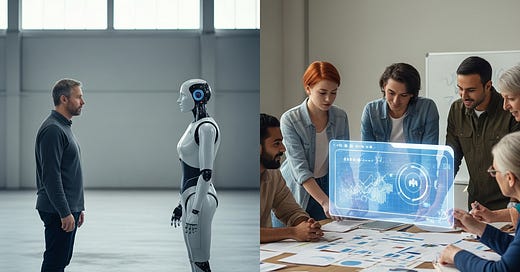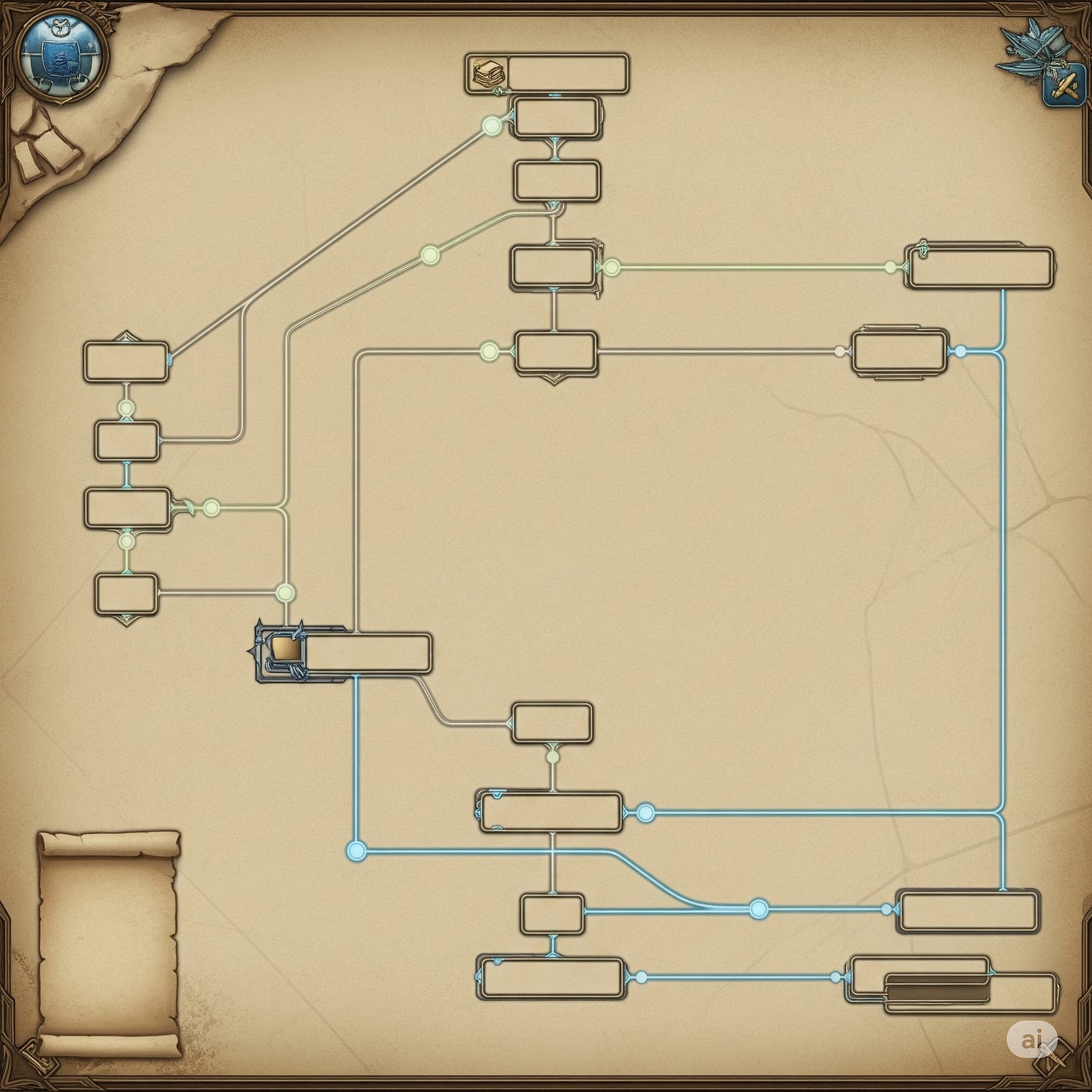AI is Single-Player for now. That's Bad. And it Won't Last
The Arc of AI Collaboration is long but it bends towards functional workflows
The Arc of Collaboration is long but it bends towards functional workflows — Kevin Kwok
I don’t know about you, but I like the future on the right.
We have AI that can write code, design ads, and discover new scientific patterns. It feels like we’ve all been handed a magic genie. But there’s a weird thing about these genies: you can only talk to them by yourself in a quiet room.
This is a step backward. Think about how we used to work. Twenty years ago, you’d write a document in Microsoft Word on your computer, all alone. When you were done, you’d save it and email it to someone. They’d make changes, save it as "Report_v2_final_JensEdits_FINAL.doc," and email it back. It was clumsy.
Then Google Docs came along. Suddenly, everyone could be in the same document at the same time. The work and the teamwork happened in the same place. This was a huge deal. It turns out that the best tools don't just help you do work; they help you do work together. A great essay called "The Arc of Collaboration" points out that this shift from "single-player" to "multiplayer" mode is how real breakthroughs happen.
3 of the top ten inventions of human history are things we use to work with each other.
source: John Lilly
But today's AI tools are almost all single-player. They've put us back in that lonely room with Microsoft Word.
Our AI Genies Make Us Hermits
Let's look at how we use AI right now:
The Coder: A programmer has an AI buddy that suggests code. It’s an amazing dialogue between one human and one AI. But her teammates can't see the conversation. It's like she has a secret superpower that only she can use.
The Marketer: A creative director asks an AI to brainstorm 50 slogans for a new shoe. The AI delivers a mountain of ideas. Now, he has to sift through them alone, pick a few, and present them to his team in a separate meeting.
The Scientist: A researcher feeds a giant dataset into an AI, which finds a weird anomaly that could be a huge discovery. The AI gives her a perfect, private report. She then has to share that report with colleagues to see if it connects to their work.
In every case, the AI does its magic in a vacuum. The collaboration part—the teamwork—is still stuck in the old world of emails, slide decks, and meetings. The work and the teamwork are in separate places.
What If AI Was a Team Sport?
Now imagine we rebuilt these tools for multiplayer mode, just like Google Docs.
The Coder Team: Instead of a private AI buddy, what if the AI was a shared coach for the whole team? It sees all the code everyone is writing at the same time. It could say, "Hey, Sarah is building something that might clash with what Mike is doing over here. Here's a way to make them fit together perfectly." The more the team codes, the smarter the AI gets about how the team works as a team. The snowball of progress starts rolling downhill, fast.
The Marketing Team: What if the AI was a giant, magic whiteboard? The AI throws a slogan on the board. The copywriter riffs on it. The artist sees the new slogan and asks the AI to generate an image to match. The AI sees the image and suggests a new, better slogan. The ideas don't just add up; they multiply.
The Science Team: What if the scientist’s AI was connected to all the other AIs in her field? When it finds that weird anomaly, it doesn't just write a private report. It instantly notifies other AIs who can check it against their own data. An AI in a chemistry lab could see the biologist's discovery and immediately say, "Wait a minute, that structure looks like this molecule I know about." Discoveries could link up in seconds, not years.
But doesn't the AI learn from all of us? Isn't using it a form of collaboration?
Technically, yes, the information content gets shared. The model learns from a vast trove of human-created text and images. But that's like saying that because thousands of people wrote books, you're "collaborating" with them when you go to the library. Reading a book is a one-way street; you're receiving information, not creating something with the author in real time. The key point is that the AI can't be the interaction between people; it has to foster the interaction between people. We need tools that enhance our direct interactions with each other, not tools that replace those interactions by acting as a middleman.
Single-Player AI Makes Us More Alone
I wrote this other piece about how isolated, personal use of a tool makes you ever more alone and isolated. Anything that makes us more isolated makes us (1) less productive (2) less happy (3) more likely to go off a deep end.
In other words, building *personalized* AI is way worse than *collaborative* AI for a lot more than just corporate productivity. And no, I don’t mean using AI’s to replace your friends. That wouldn’t work and anyone who thinks that would work has a very dark (and mistaken) view of the future.
Multiplayer Will Be More Important. It always is.
We’re currently giving incredible tools to individuals. But the real game-changer isn't making one person faster. It's making a team smarter. The shift from single-player to multiplayer AI will be a much bigger deal.
Today's AI tools are just the warm-up act. The future isn’t about you and your personal AI. It's about what happens when all of us, and all of our AIs, can think together.
Postscript: So where is it?
So if multiplayer AI is such a no-brainer, where is it? The absence of these tools probably isn't an oversight; it's more likely a case of unlocking things in the right order on a technology tree; Think of it like a video game where you can't build a starship until you've first mastered mining basic minerals and then learned how to smelt alloys.
Right now, we're all just getting our hands on the raw materials—these powerful but solitary single-player AI models. We first need to get really good at using these foundational tools, figuring out what they do best and letting them mature into stable, predictable applications.
Maybe only after we’ve mastered that "single-player" tech can we effectively advance up the tree to the next, more complex challenge: figuring out how to plug them all together to build something far more powerful. At least that’s how single-player office apps went. We got Adobe Photoshop before Figma, and MS Word before Google Docs.






